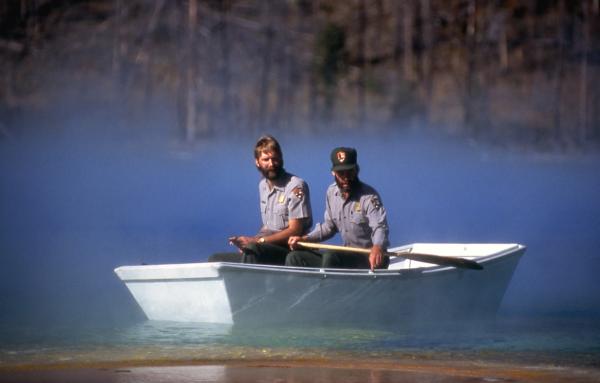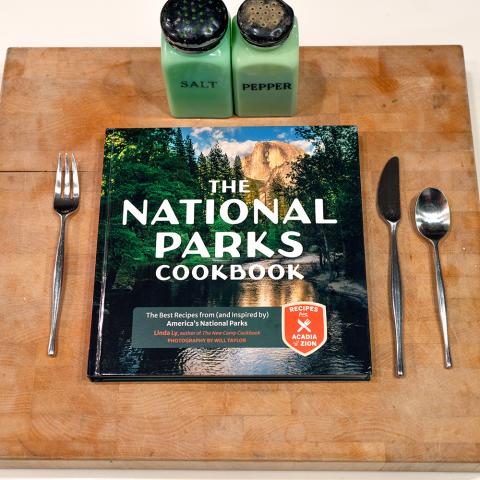Editor's note: Yellowstone Caldera Chronicles is a weekly column written by scientists and collaborators of the Yellowstone Volcano Observatory. This week's contribution is from Michael Poland, geophysicist with the U.S. Geological Survey and Scientist-in-Charge of the Yellowstone Volcano Observatory.
Grand Prismatic Spring is the largest hot spring in the United States, and one of the largest in the world. The feature is located in Midway Geyser Basin—so named because it is between the Upper and Lower Geyser Basins—and is one of the most popular attractions in Yellowstone National Park.

Aerial view of Excelsior Geyser (in the foreground) and Grand Prismatic Spring in Yellowstone’s Midway Geyser Basin. The colors around the thermal features are locations of different thermophile communities/NPS, Jim Peaco; June 22, 2006.
The first accounts of Grand Prismatic Spring are probably from 1839, when a group of trappers noted a “boiling lake” 300 feet across. Such an impressive feature could only be Grand Prismatic Spring, and in fact the description left by trapper Osborne Russell is the earliest written account of a Yellowstone thermal feature that can be definitely identified. Russell’s account is worth reproducing in its entirety:
“At length we came to a boiling Lake about 300 ft in diameter forming nearly a complete circle as we approached on the South side The stream which arose from it was of three distinct Colors from the west side for one third of the diameter it was white, in the middle it was pale red, and the remaining third on the east light sky blue Whether it was something peculiar in the state of the atmosphere the day being cloudy or whether it was some Chemical properties contained in the water which produced this phenomenon I am unable to say and shall leave the explanation to some scientific tourist who may have the Curiosity to visit this place at some future period - The water was of deep indigo blue boiling like an immense cauldron running over the white rock which had formed [round] the edges to the height of 4 or 5 feet from the surface of the earth sloping gradually for 60 or 70 feet. What a field of speculation this presents for chemist and geologist.”
It would be several decades before any chemists or geologists visited the site to better understand the feature
The 1870 Langford-Doane-Washburn expedition—one of the first organized explorations of the Yellowstone region—also noted the spring as well as neighboring Excelsior Geyser, but they were running short of provisions and so were not able to spend much time in the area.
The most detailed early description of the feature came from the Hayden expedition of 1871—the first federally funded exploration of Yellowstone. In his report, geologist Ferdinand Hayden recorded: “This is perhaps the handsomest spring in the whole Park, and it is certainly one of the largest, if not the largest. … I have named it Prismatic on account of the brilliant coloring displayed in it.”
The actual diameter of Grand Prismatic Spring at its widest point is 370 feet—longer than an American football field!
The colors that make Grand Prismatic famous are a result of extreme organisms living in the hot water. The center of the pool is near boiling temperature and has a brilliant blue color. Away from the center, different thermophilic species thrive at different temperatures, giving the pool the characteristic pigments that are found not just at Grand Prismatic, but many hot springs in Yellowstone National Park.
Grand Prismatic is so large, however, that it is hard to access its depths from the shore. To learn more about the characteristics of the spring, a feat of daring was required by park Geologist Roderick “Rick” Hutchinson.
In the early 1990s, Hutchinson worked with boat-builder Mark Poppert, of Livingston, Montana, to design a craft that could be used to investigate Yellowstone’s largest hot springs. The structure of the boat was based on a similar vessel that was used to explore hot springs in New Zealand. Dubbed “Little Dipper,” the boat was 8 feet long, 4 feet wide, and exceptionally stable, with flotation chambers that would ensure that it would not sink—it would still float even if the bottom fell out! Little Dipper also included a porthole in the middle of the boat, allowing direct access to the water for instruments and measurements without having to lean over the side.

Yellowstone National Park employees Rick Hutchinson (right) and Jim Peaco (left) guide the specially designed Little Dipper boat into the boiling waters of Grand Prismatic Spring to collect measurements of the temperature and structure of the feature. National Park Service photo by Josh Robbins in 1996.
Hutchinson and colleagues rowed out to the boiling water at the center of Grand Prismatic multiple times, but never wore life vests. “It's not going to be much use to you if you go in the drink," was Hutchinson’s quip. Hutchinson attempted a sounding to determine the depth of the spring and found that it was over 120 feet, but that depth is uncertain—the line might have been folded. The greatest depth measured in other springs in the region is about 40 feet.
Although no longer in use, Little Dipper made multiple trips onto Grand Prismatic Spring, as well as other springs in Yellowstone (including Morning Glory Pool), for research and to clean out litter.
Tragically, Hutchinson and visiting geologist Diane Dustman were killed in an avalanche near Heart Lake in 1997. Rick’s incredible legacy lives on, however, in the better understanding he provided of Yellowstone’s remarkable thermal features, including Grand Prismatic Spring—a testament to extreme life on Earth.




 Support Essential Coverage of Essential Places
Support Essential Coverage of Essential Places






